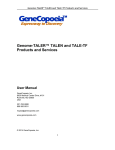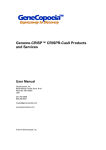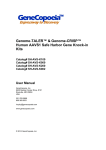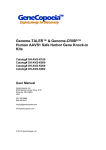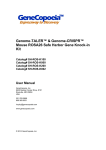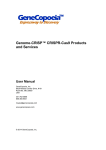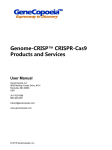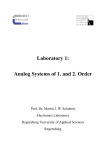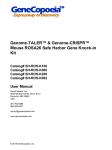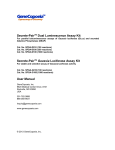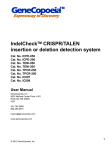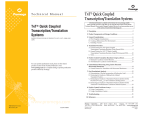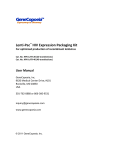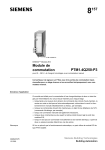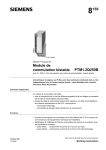Download Genome-TALER™ TALEN and TALE-TF Products
Transcript
Genome-TALER™ TALEN and TALE-TF Products and Services Genome-TALER™ TALEN and TALE-TF Products and Services User Manual GeneCopoeia, Inc. 9620 Medical Center Drive, #101 Rockville, MD 20850 USA 301-762-0888 866-360-9531 [email protected] www.genecopoeia.com © 2014 GeneCopoeia, Inc. 1 Genome-TALER™ TALEN and TALE-TF Products and Services USER MANUAL Genome-TALER™ TALEN and TALE-TF Products and Services I. II. III. IV. V. VI. VII. VIII. I. Introduction to TAL effectors Related Services Examples Overview of Genome Editing Using TALEN and TALE-TF Critical Steps References Appendix Licensing and Warranty Statement Introduction Transcription activator-like (TAL) effectors are proteins secreted by Xanthomonas bacteria when they infect plants. These proteins can activate the expression of plant genes by recognizing and binding host plant promoter sequences through a central repeat domain consisting of a variable number of ~34 amino acid repeats. The residues at the 12th and 13th positions of each repeat are hyper-variable. There appears to be a simple one-to-one code between these two critical amino acids in each repeat and each DNA base in the target sequence, e.g. NI = A, HD = C, NG = T, and NN = G or A. Recent work has demonstrated that the NH RVD has greater specificity and comparable affinity for G compared with NN. Therefore, the NN RVD has been replaced for G recognition by NH. GeneCopoeia also uses the N* RVD for recognition of 5-methyl cytosine (Figure 1). Figure 1. Top: Schematic of a TAL effector. Bottom: Typically-used RVD recognition code 2 Genome-TALER™ TALEN and TALE-TF Products and Services TAL effectors have been utilized to create site-specific gene-editing tools by fusing target sequence-specific TAL effectors to nucleases (TALENs), transcription factors (TALE-TFs) and other functional domains (Figure 2). These fusion proteins can recognize and bind chromosome target sequences specifically and execute their gene-editing functions, such as gene knockout, knockin (with donor plasmid), modification, activation, repression and more. Unlike zinc fingers’ nucleotide triplet recognition, TAL effector domains recognize single nucleotides, which allow researchers to be able to specifically target whatever sequence they want. Figure 2. Top: Typical TALEN design strategy. Bottom: Typical TALE-TF design strategy. Advantages Target any gene in any cell Highly sequence-specific genome editing For gene knockout, knockin, mutagenesis, activation, repression and more Flexible TAL effector design of binding and functional domains, such as TALEN and TALETF 3 Genome-TALER™ TALEN and TALE-TF Products and Services II. Products and Services Services Description Surrogate reporter assay Plasmid-level functional validation. Detects activities of genome editing tools by observing the expression level of a surrogate reporter gene. T7 endonuclease I assay Chromosomal-level functional validation. Detects the presence of indels created by TALEN-mediated NHEJ repair at the specific target site of the chromosome. Validation Donor clone services (see appendix) Stable cell line services (see appendix) Transgenic mouse services Donor clone design and construction Customized plasmids designed to specifically transfer your gene of interest, selection marker or other genetic elements into targeted sites through homologous recombination (HR) induced by our TALEN. We offer various donor vector choices with different selection markers and genetic elements built in for your experiment purpose. Monoclonal colony Monoclonal stable cell line with TALEN-mediated genome modifications. Cell bank Creation of a cell bank of monoclonal stable cell line with TALEN-mediated genome modifications. Transgenic mouse Transgenic mice with TALEN-mediated genome modifications. 4 Genome-TALER™ TALEN and TALE-TF Products and Services III. Examples Figure 3. TALENs knockdown eGFP expression. (A) eGFP TALENs expression validation: ~80% confluence HEK293T cells were transfected with 0.8 µg plasmid per well in a 6-well plate. The cells were harvested 48 hrs post-transfection. 1/20th of the cell lysate per well was analyzed for western blot using anti-Flag antibody in a SDS-PAGE (8% resolve gel) , with the untransfected cell lysate as the negative control. (B) TALENs knockdown eGFP expression: HEK293T cells in a 6-well plate were co-transfected with EX-EGFP-Lv105 and TALEN plasmids or control plasmid. EGFP expression was visualized under a microscope (Nikon Eclipse Ti, exposure time: 600ms) 48hrs post-transfection Figure 4. NTF3 TALE-TF regulates endogenous NTF3 transcription. Endogenous NTF3 transcription activation by TALE-TF: HEK 293T cells transfected with the NTF3 TALE-TF (6 well plate, 1 µg plasmid per well) exhibited a 17-fold increase in the amount of NTF3 mRNA compared to cells transfected with an empty vector. Measurements were performed in triplicate. 5 Genome-TALER™ TALEN and TALE-TF Products and Services IV. Overview of Genome Editing Using TALEN and TALE-TF 6 Genome-TALER™ TALEN and TALE-TF Products and Services V. Critical Steps A. Plasmid propagation We recommend propagating the plasmids provided before your gene targeting experiment. Plasmids can be transformed using standard conditions suitable in any RecA- and EndA- E.coli competent cells. For transformation of TALE product plasmids, we suggest plating 50-200µl of transformed cells on fresh LB-Ampicillin plates (50µg/ml). Incubate the plates at 37°C overnight. Inoculate colonies from the transformation and grow them at 37°C overnight in ~200ml of LB media containing 50µg/ml Ampicillin. Use an endotoxin-free plasmid DNA maxiprep kit to extract plasmid DNA after overnight growth. To confirm the integrity of the amplified plasmids, we recommend restriction digestion analysis or direct sequencing. B. Characterization of TALE-TF or TALEN modified cells (Option A) Measuring TALE-TF transcriptional activation using qRT-PCR For TALE-TFs, qRT-PCR quantitatively measures the increase in transcription driven by the TALE-TF. GeneCopoeia provides validated qPCR primers for most genes in the human genome. Full services covering RNA extraction, reverse transcription, quantitative PCR, and data analysis are also available from GeneCopoeia. There are a wide variety of qRT-PCR protocols. We provide brief details here. 1. 24 or 48hr post-transfection, collect cells to extract total RNA. 2. Measure the RNA concentration using a UV spectrophotometer. 3. Perform reverse transcription to get cDNA. 4. Perform quantitative PCR 5. Analyze data and calculate the level of gene activation using the ΔΔCt method. (Option B) Measuring TALEN cutting efficiency using mismatch cleavage assay TALEN-modified DNA will have a few bases of sequence deletion near the TALEN cut site because of NHEJ exonuclease activity. We recommend using the Surveyor mutation detection kit for standard gel electrophoresis (Transgenomic, cat. no. 706025) for this assay. Alternatives include the Cel1, T7, mung bean and S1 nucleases. The Surveyor procedure is carried out according to the manufacturer’s instructions and is described in greater detail in the Surveyor manual. We provide brief details here. 7 Genome-TALER™ TALEN and TALE-TF Products and Services 1. 24 or 48 hr post-transfection, collect cells to extract genomic DNA. 2. PCR amplify the region surrounding the sgRNA target site. 3. Check the PCR result by running 5 μl of PCR product on a 2% agarose gel. For all templates, it is important to make sure that there is only a single band corresponding to the intended product for the primer pair. The size of this band should be the same as calculated from the distance between the two primer annealing sites in the genome. CRITICAL STEP: If multiple amplicons are generated from the PCR, redesign the primers and reoptimize the PCR conditions to avoid off-target amplification. In difficult cases in which a single-band product cannot be achieved, it is acceptable to gel-extract the correct-length band before proceeding with heteroduplex reannealing and Surveyor nuclease digestion. 4. DNA heteroduplex formation. At this point, the amplified PCR product includes a mixture of both TALEN-modified and unmodified genomic DNA. Place 300 ng of the PCR product in a thermocycler tube and perform the cross-hybridization. 5. Surveyor Nuclease S digestion. To treat the cross-hybridized homo- and heteroduplexes with Surveyor Nuclease S to determine TALEN cleavage efficiency. C. Transfection of TALE-TF or TALEN into target cells Option A if you are using TALE-TF for transcriptional modulation, or option B if you are using TALEN for testing nuclease activity. 1. 2. Plate ~100,000 to 300,000 cells/well in a 6-well plate according to established recommended conditions for the cell type(s) being transfected. Scale up and down the culture if needed. On the day before transfection, trypsinize and count the cells. The number of cells plated in each well should be determined so that they are 70-80% confluent at the time of transfection. The next day, prepare transfection complexes of TALEN and TALE-TF using a suitable transfection reagent according to the manufacturer’s recommended instructions. Leave the transfection complexes on the cells to react for >6 hours. Option A) 2.0µg of TALE-TF Option B) 1.0µg of LEFT TALEN + 1.0µg of RIGHT TALEN Notes: including appropriate controls according to your experiment. Tech Notes: 1) 2) 3) Since transfection efficiencies vary across different cell lines, we recommend optimizing the input of plasmid to transfection reagent for best results. For optimal results, we recommend complexing of DNA with transfection reagent in serumand antibiotic-free media and cells growing in complete media. For hard-to-transfect cells (e.g. primary, stem, hematopoietic), it may be advisable to utilize a nonpassive transfection method such as NucleoFection (Lonza) or Neon system (Life Technologies). Please follow recommended transfection guidelines provided by the manufacturer for specific cell type(s) being transfected. 8 Genome-TALER™ TALEN and TALE-TF Products and Services 3. 4. 24 hours post-transfection, remove transfection media and split the cells 1:10 and 1:20 in complete growth media w/antibiotics. Plate cells into 6-well plates and save a set of plate(s) for characterization. Allow cells to recover for 24 hours. Begin antibiotic selection 48 hours post-transfection. We recommend optimizing concentration of antibiotic for best results. Tech Note: Establishing a kill-curve on untransfected cells can determine the effective working antibiotic concentration for a target cell line. The concentration of antibiotic that kills >90% of cells after 48hours of selection is the correct dose for the cells being selected. Example: For HEK293T cells using EndoFectin reagent, transfect TALEN or TALE-TF 1) Plate cells Plate HEK293T cells onto 6-well plates ~24 h before transfection. The number of cells plated in each well should be determined so that they are 70-80% confluent at the time of transfection 2) Prepare the DNA–Opti-MEM mix. Option A): mix 2.0μg of TALE-TF plasmid DNA with 50μl of Opti-MEM. Notes: include controls (e.g., a reporter plasmid or mock transfection) to monitor transfection efficiency and cell health, respectively. Option B): mix 1.0μg of each Left TALEN and Right TALEN (2μg total) with 50μl of OptiMEM. Notes: control transfections can be done by omitting one or both of the TALENs. Include controls (e.g., a reporter plasmid or mock transfection) to monitor transfection efficiency and cell health, respectively. 3) Prepare the EndoFectin™–Opti-MEM solution Dilute 6μl of EndoFectin™-Plus with 50μl of Opti-MEM. Mix the solution thoroughly at room temperature. 4) Prepare DNA- EndoFectin™ complex Add the diluted EndoFectin™ reagent drop-wise to the DNA solution while gently vortexing the DNA-containing tubes. (Note: Do not reverse the addition sequence.) Incubate the mixture for 10-25 minutes at room temperature to allow the DNA-EndoFectin™ complex to form. 5) Transfect cells Add the DNA-EndoFectin™ complex directly to each well and gently swirl the plates/dishes. 9 Genome-TALER™ TALEN and TALE-TF Products and Services D. Validation of TALEN modified and HR recombinant cells 1. To confirm donor vector integration specifically at a target site, junction-PCR can be performed using PCR primer pairs that flank the 5’ homology arm and 3’ homology arm. 2. Protocol for junction-PCR 1) Primers should be diluted to 10μM before use. Validation of either the 5’ or 3’ homology arms for donor integration is usually sufficient; however, both arms can be done for additional confirmation. 2) Protocol details for junction-PCR assay: a) Isolate genomic DNA from positive control cells or test sample cells using a suitable genomic DNA miniprep kit. Please follow the protocol recommended by the manufacturer. b) Perform junction-PCR (PCR reaction below) Genomic DNA (60~100ng/µl) TALEN cut+ positive control donor 1μl Positive control donor only 1μl 10μM 5' (or 3’) PCR Primer Mix 1μl 1μl 5×UltraPFTM Buffer (Mg2+ free) 5μl 5μl 10 mM dNTPs 0.5μl 0.5μl 20mM MgSO4 2.5μl 2.5μl UltraPF (5U/μl) 0.25μl 0.25μl PCR-grade distilled water 14.75μl 14.75μl Total 25μl 25μl Reagent 98°C, 5min 98°C, 20sec 55°C, 30sec 35 cycles 72°C, 1min 72°C, 7min Hold at 4~16°C Run the PCR reaction on a 1% Agarose/EtBr gel in 1X TAE buffer to confirm the junctionPCR result. Sample results for 5’ and 3’ junction-PCR assay depend on design. 10 Genome-TALER™ TALEN and TALE-TF Products and Services Tech Note: 1) The 3’ junction PCR band and 5’ junction PCR band may differ in brightness because the amplification efficiency may be different due to the nature of the chromosomal structure, modification and sequence around that region. 2) One positive in junction PCR is sufficient to confirm the integration. 3) It is possible that random integration can coexist with site-specific integration. Negative selection can be used to detect coexisting random integration. E. Clonal isolation of cell lines Serial dilution is widely used to isolate single clones with desired modifications, followed by an expansion period to establish a new clonal cell line. Like most clonal isolation methods, there is no guarantee that the colonies arose from single cells. A second round is advised to increase the likelihood of clonal isolation. Also, it is worth noting that cell types can vary substantially in their responses to single-cell isolation, therefore literature specific to the cell type of interest should be consulted. 1. Fill each well of a sterile 96-well plate with 100µl of medium except for well A1, which should remain empty. Figure 5: Illustration of serial dilution. 2. Add 200µl cell suspension to well A1. Mix 100µl from A1 with the medium in well B1. Avoid bubbles. Continue this 1:2 dilution through column 1. Add 100µl of medium back to column 1 so that wells A1 through H1 contain 200µl. 3. Mix cells and transfer 100µl of cells from column 1 into column 2. Mix by gently pipetting. Avoid bubbles. Repeat these 1:2 dilutions through the entire plate. Bring the final volume to 200µl by adding 100µl of medium to all but the last column of wells. 4. Incubate plates undisturbed at 37℃. 11 Genome-TALER™ TALEN and TALE-TF Products and Services 5. Cells will be observable via microscopy over 3 days and be ready to score in 5-8 days, depending on the growth rate of cells. Mark each well on the cover of the plate indicating which well contains a single colony. These colonies can later be subcultured from the well into larger vessels. Tech Note: 1) Adding 4000 cells in well A1 (2×104 cells/ml) is a good starting concentration. Increase the concentration for more difficult to grow cell lines. 2) If the reporter gene is fluorescent, determine which of these colonies express it. If the reporter gene is not observable you will have to wait until later in the culture process. 3) Label each well with a single colony using a unique identification number and record this number on the plate and in your notebook. VI. References 1. Boch, J. et al. Breaking the code of DNA binding specificity of TAL-type III effectors. Science. 2009 326(5959):1509-12 2. Moscou, M. et al. A simple cipher governs DNA recognition by TAL effectors. Science. 2009 326(5959):1501 3. Christian, M. et al. Targeting DNA Double-Strand Breaks with TAL Effector Nucleases. DOI: 10.1534/genetics.110.120717 4. Morbitzera, R. et al. Regulation of selected genome loci using de novo-engineered transcription activator-like effector (TALE)-type transcription factors. www.pnas.org/cgi/doi/10.1073/pnas.1013133107 5. Cermak, T. et al. Efficient design and assembly of custom TALEN and other TAL effectorbased constructs for DNA targeting. Nucleic Acids Research, 2011, Vol. 39, No. 12 e82 doi:10.1093/nar/gkr218 6. Li, T. et al. Modularly assembled designer TAL effector nucleases for targeted gene knockout and gene replacement in eukaryotes. Nucleic Acids Research, 2011, Vol. 39, No. 14 6315–6325 doi:10.1093/nar/gkr188 7. Zhang, F. et al. Programmable Sequence-Specific Transcriptional Regulation of Mammalian Genome Using Designer TAL Effectors. Nat Biotechnol. 2011 February ; 29(2): 149–153. doi:10.1038/nbt.1775. 12 Genome-TALER™ TALEN and TALE-TF Products and Services VII. Appendix Donor services GeneCopoeia offers customized donor clone design and construction services. Donor clones are customized plasmids designed to specifically transfer your gene of interest, selection marker or other genetic elements into a target site via HR-mediated repair of DSBs induced by site-specific TALENs or CRISPR-Cas9. Donor vectors are available with several options for selection markers and genetic elements to meet your experimental needs. Donor vector types Vector Promoter Reporter Gene Selection Marker LoxP Site pDonor-D01 EFa1 copGFP Puromycin N/A pDonor-D02 CMV copGFP Neomycin N/A pDonor-D03 CMV N/A Neomycin N/A pDonor-D04 CMV N/A Puromycin N/A pDonor-D05 EFa1 N/A Neomycin N/A pDonor-D07 EFa1 copGFP Puromycin/TK Loxp pDonor-D08 CMV copGFP Neomycin/TK Loxp pDonor-D09 EFa1 N/A Puromycin/TK Loxp pDonor-D10 CMV N/A Neomycin/TK Loxp 13 Genome-TALER™ TALEN and TALE-TF Products and Services Figure 6. Maps of donor vectors 14 Genome-TALER™ TALEN and TALE-TF Products and Services Stable cell line services GeneCopoeia offers monoclonal stable cell line service with customized TALEN-mediated genome modifications. Cell banking service is also available. 15 Genome-TALER™ TALEN and TALE-TF Products and Services VIII. Limited Use License and Warranty Limited Use License Following terms and conditions apply to use of the Genome-TALERTM TALEN and TALE-TF products and services (the Product). If the terms and conditions are not acceptable, the Product in its entirety must be returned to GeneCopoeia within 5 calendar days. A limited End-User license is granted to the purchaser of the Product. The Product shall be used by the purchaser for internal research purposes only. The Product is expressly not designed, intended, or warranted for use in humans or for therapeutic or diagnostic use. The Product must not be resold, repackaged or modified for resale, or used to manufacture commercial products or deliver information obtained in service without prior written consent from GeneCopoeia. This Product should be used in accordance with the NIH guidelines developed for recombinant DNA and genetic research. Use of any part of the Product constitutes acceptance of the above terms. Limited Warranty GeneCopoeia warrants that the Product meets the specifications described in the accompanying Product Datasheet. If it is proven to the satisfaction of GeneCopoeia that the Product fails to meet these specifications, GeneCopoeia will replace the Product. In the event a replacement cannot be provided, GeneCopoeia will provide the purchaser with a refund. This limited warranty shall not extend to anyone other than the original purchaser of the Product. Notice of nonconforming products must be made to GeneCopoeia within 30 days of receipt of the Product. GeneCopoeia’s liability is expressly limited to replacement of Product or a refund limited to the actual purchase price. GeneCopoeia’s liability does not extend to any damages arising from use or improper use of the Product, or losses associated with the use of additional materials or reagents. This limited warranty is the sole and exclusive warranty. GeneCopoeia does not provide any other warranties of any kind, expressed or implied, including the merchantability or fitness of the Product for a particular purpose. GeneCopoeia is committed to providing our customers with high-quality products. If you should have any questions or concerns about any GeneCopoeia products, please contact us at 301-762-0888. © 2014 GeneCopoeia, Inc. For Research Use Only. © 2014 GeneCopoeia, Inc. Trademark: Genome-TALERTM, EndoFectinTM, GeneCopoeiaTM (GeneCopoeia, Inc.) 16 TN-130813
















